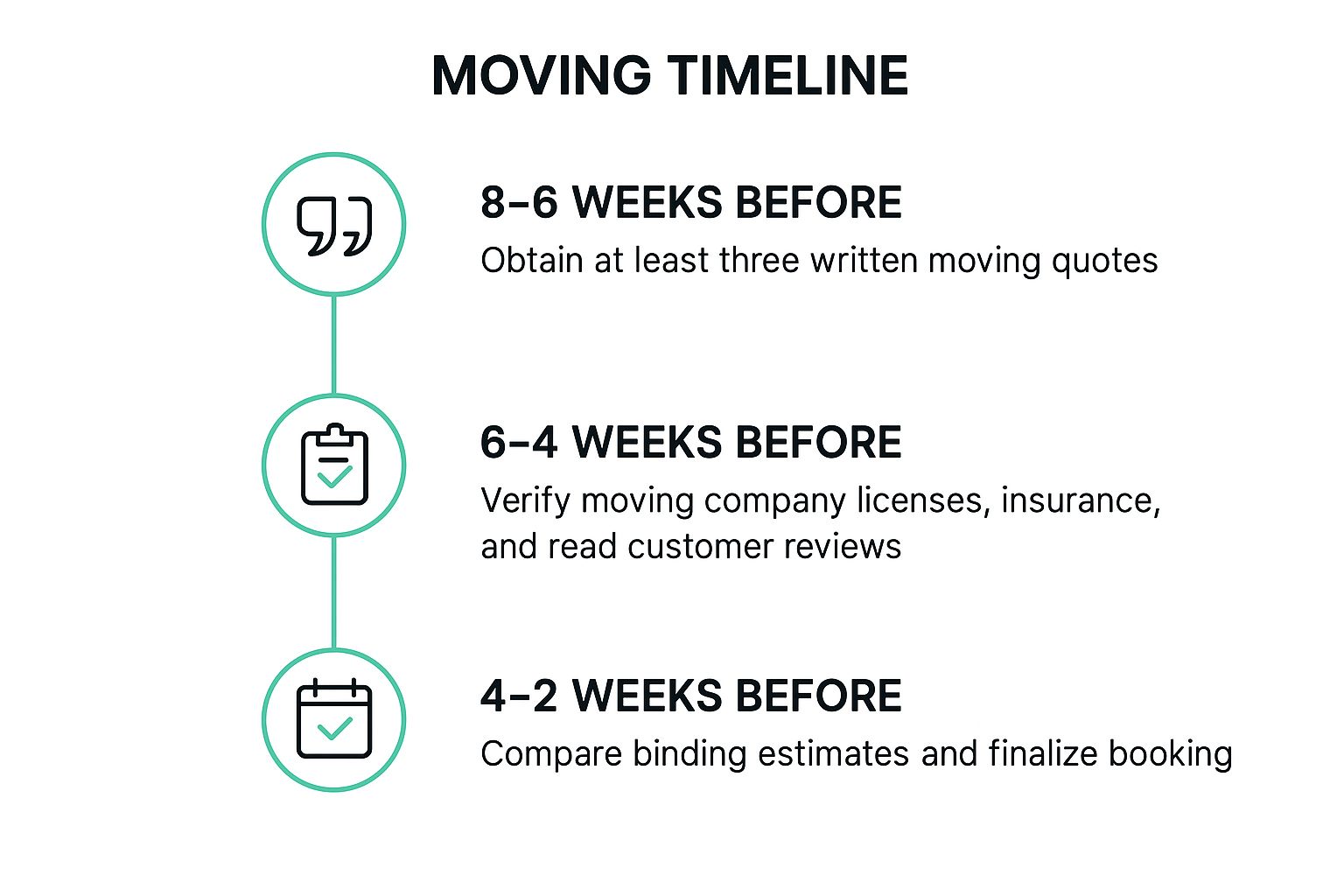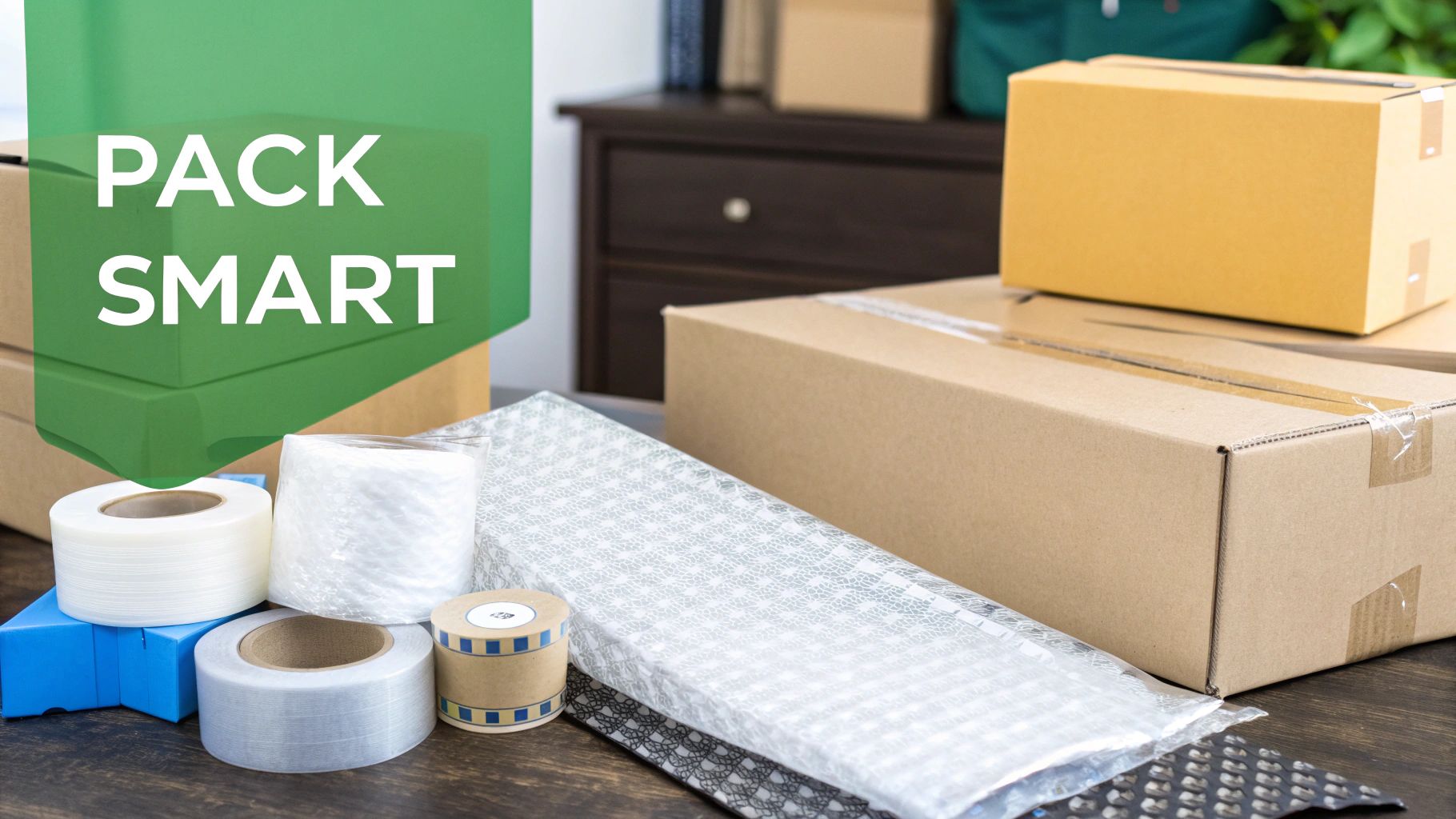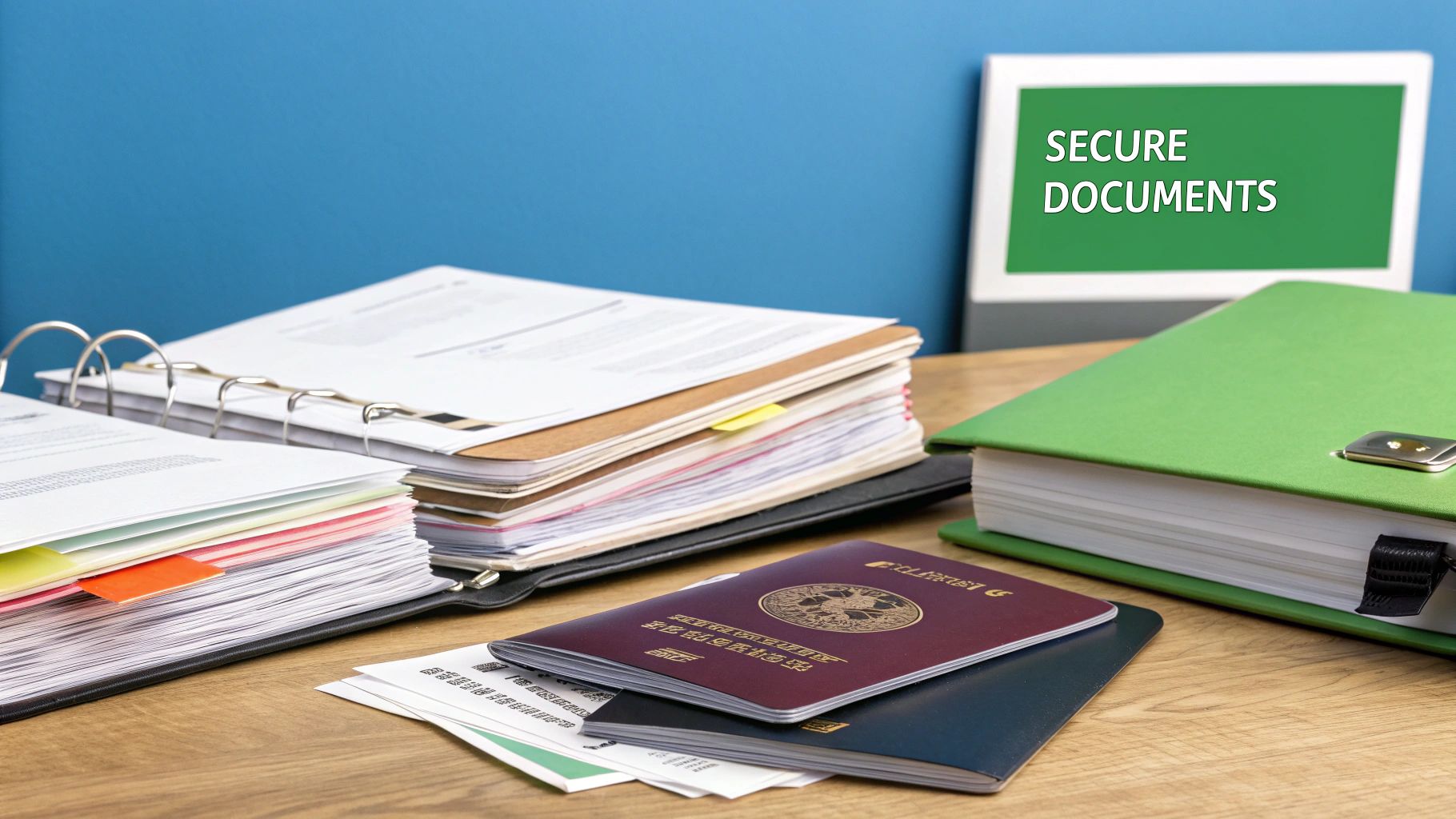Moving house can feel like orchestrating a symphony of chaos. Between the endless boxes, tight deadlines, and the sheer volume of tasks, it's easy to feel overwhelmed by the process. What if you could transform that chaos into a well-coordinated, stress-free operation? This is where a comprehensive removalist checklist becomes your most valuable tool, acting as a strategic roadmap from your old front door to your new one.
This guide is designed to be your definitive resource, breaking down the entire relocation journey into manageable, actionable stages. We will cover everything from the crucial initial decluttering phase months in advance to the final inspection of your new home. Forget generic advice; this isn't just a list, it's a detailed plan filled with expert insights, practical tips, and specific guidance to help you sidestep common moving pitfalls and costly mistakes.
We've structured this checklist to be straightforward and immensely practical. You will learn how to strategically downsize your possessions, research and book the right moving company, and create a timeline that keeps you on track without last-minute panic. We'll also dive into the specifics of packing fragile items, notifying essential parties of your address change, and managing utility transfers seamlessly. Whether you're moving a small apartment across town or relocating an entire family home, this ultimate removalist checklist will ensure no detail is overlooked. It's time to turn a daunting task into a smooth, organised transition into your next chapter.
1. Declutter and Downsize Possessions
Before you even think about booking removalists or buying a single packing box, the most crucial first step is to systematically declutter and downsize your possessions. This process involves sorting through every item you own to decide what is essential enough to take to your new home and what can be donated, sold, or discarded. The less you have to move, the simpler, faster, and more cost-effective your entire relocation will be. This is a foundational step in any effective removalist checklist.

Popularised by figures like Marie Kondo, whose clients often reduce their belongings by significant margins, this approach transforms moving from a logistical nightmare into a meaningful fresh start. By reducing volume, you directly lower removalist costs, which are often based on the cubic metres your goods occupy.
How to Implement This Strategy
To tackle this effectively, approach it systematically rather than randomly. Going room by room, or even category by category (e.g., all clothing, then all books), prevents you from becoming overwhelmed.
- Create Sorting Zones: Designate clear areas in your home for four distinct piles: Keep, Donate, Sell, and Discard. Use signs or coloured bins to keep things organised.
- Start with the Impersonal: Begin with areas and items you have little emotional attachment to, such as the laundry, linen cupboard, or garage. This builds momentum and makes it easier to tackle sentimental items later.
- Apply the One-Year Rule: A practical guideline used by many, including military families who move frequently, is the 'one-year rule'. If you haven't used an item in the past year and it holds no significant sentimental value, it's a strong candidate for donation or disposal.
- Digitise Sentimental Clutter: For items you cherish but don't have space for, like children's artwork or old greeting cards, take high-quality photos. This allows you to preserve the memory without the physical clutter.
Pro Tip: Schedule your donation pickups or trips to the charity shop well in advance. Leaving this to the last minute can add unnecessary stress right before moving day. Services like Salvos Stores often offer free collection for larger furniture items.
2. Research and Book a Reputable Moving Company
Once you have an idea of what you're moving, the next critical task is to find the right professionals for the job. This involves thoroughly investigating, comparing, and selecting a removalist that aligns with your specific needs, budget, and timeline. Simply choosing the cheapest option can lead to damaged goods, hidden fees, and immense stress. A systematic approach to this step in your removalist checklist ensures your belongings are in safe, professional hands.
This process is underpinned by standards and accountability popularised by organisations like the Australian Furniture Removers Association (AFRA) and consumer review platforms. Engaging an accredited or highly-rated company like Allied, known for its comprehensive services, or a local specialist like Two Men and a Truck, provides peace of mind and recourse if issues arise. By investing time in research, you safeguard your assets and set the stage for a smooth relocation.
The following timeline visualises the key stages for researching and securing your chosen removalist, ensuring you stay organised and on schedule.

This structured timeline helps prevent the last-minute scramble that often leads to settling for a less-than-ideal moving company.
How to Implement This Strategy
A methodical approach to vetting and booking removalists will save you significant headaches. It's about gathering information, verifying credentials, and making an informed decision rather than a rushed one.
- Obtain Multiple Written Estimates: Never settle for the first quote. Contact at least three different removalist companies to get a detailed, written estimate. This allows you to compare pricing, included services, and potential additional charges. Be wary of quotes given over the phone without a home inspection.
- Verify Credentials and Insurance: Ensure the company is a registered business with a valid ABN. For extra assurance, check if they are accredited by AFRA, which requires members to meet high standards for equipment, vehicles, and staff training. Always ask for proof of their public liability and transit insurance.
- Scrutinise Reviews and Testimonials: Look beyond the company’s website. Check independent review platforms like ProductReview.com.au or Google Reviews to get an unbiased view of other customers' experiences. Pay attention to how the company responds to both positive and negative feedback.
- Book Well in Advance: To secure your preferred moving date and potentially better rates, aim to book your removalist 4-6 weeks in advance, especially during peak seasons like summer or the end of the month.
Pro Tip: When comparing quotes, look closely at what is included. Is packing material extra? Are there additional fees for stairs, long-carry distances, or difficult access? A seemingly cheaper quote might end up costing more once these extras are added.
3. Create Comprehensive Moving Timeline
Once you've committed to decluttering, the next vital element is to map out your entire move with a detailed timeline. A comprehensive moving timeline breaks down the overwhelming process into a series of smaller, manageable tasks spread over several weeks. This strategic schedule ensures nothing is overlooked, from booking your removalist to changing your address, making it an indispensable part of any removalist checklist.
This method is a cornerstone of professional relocation services, with corporate and military move coordinators often using 8-12 week plans to ensure seamless transitions. By adopting this project management approach, you can significantly reduce stress and avoid the last-minute panic that plagues so many moves. It provides a clear roadmap, giving you control and visibility over the entire process.
How to Implement This Strategy
The most effective way to build your timeline is to work backwards from your confirmed moving day. This simple shift in perspective helps you prioritise tasks and allocate sufficient time for each one, preventing critical steps from being rushed or missed.
- Work Backwards from Moving Day: Start with your move-out date and schedule key milestones in reverse. For example, if moving day is on the 30th, final packing should be done by the 28th, utilities disconnected on the 29th, and so on.
- Divide and Conquer: Break the timeline into logical phases: 8 weeks out (research and booking), 4 weeks out (packing non-essentials), 1 week out (confirming details), and moving week (final tasks).
- Assign Responsibilities: If you're not moving alone, delegate specific tasks to family members or housemates within the timeline. This shared accountability makes the process more efficient and less burdensome for one person.
- Use Digital Tools: Leverage digital calendars, spreadsheets, or moving apps like Trello or Asana. These tools make it easy to track progress, set reminders, and share the plan with others involved in the move.
Pro Tip: Always build in buffer time. Unexpected delays are common, whether it's a settlement date shifting or a painter taking longer than expected. Adding a few extra days into your schedule for key tasks provides a crucial safety net.
4. Notify Important Parties of Address Change
Long before the final box is taped shut, one of the most critical administrative tasks in any removalist checklist is to systematically inform all relevant organisations and individuals of your new address. This crucial step ensures the uninterrupted flow of important mail, services, and communications. Neglecting this can lead to missed bills, lapsed insurance policies, privacy risks from mail sent to your old address, and significant administrative headaches down the line.
The importance of this process is underscored by requirements from government bodies like the Australian Taxation Office (ATO) and financial institutions, which rely on accurate address details for security and legal compliance. Properly managing your change of address prevents service disruptions and protects your personal information during the transition to your new home.
How to Implement This Strategy
A methodical approach is essential to ensure no one is missed. Begin this process at least four weeks before your moving date to allow ample time for the changes to be processed by various systems.
- Create a Comprehensive Checklist: Group your contacts into categories: Government (ATO, electoral commission, Centrelink), Financial (banks, credit cards, superannuation funds), Utilities (electricity, gas, internet), Health (doctors, dentist, Medicare), and Personal (subscriptions, memberships, friends, and family). This organised approach prevents oversights.
- Prioritise and Go Digital: Start with the most critical notifications, such as your bank and insurance providers. Many organisations now offer simple online forms to update your details, which is often faster and more efficient than calling or visiting in person.
- Set Up Mail Redirection: As a crucial safety net, arrange for Australia Post to redirect your mail from your old address to your new one. This service catches any mail from senders you may have forgotten to notify, giving you peace of mind.
- Keep Records of Updates: Note down when and how you notified each party. This log is invaluable if a company claims they were not informed or if mail continues to be sent to your old residence.
Pro Tip: Use your comprehensive list as a reference after you move. In the first few weeks, as redirected mail arrives, you can use it to identify any organisations you missed and update your address with them directly. You can get more guidance with a detailed moving house change of address checklist.
5. Pack Strategically with Proper Materials
Once decluttering is complete, the next critical phase is to pack your belongings methodically using appropriate materials and techniques. This isn't just about putting things in boxes; it's a strategic process designed to protect your items from damage during transit and to make unpacking efficient and organised. Using the right supplies and a clear system ensures everything arrives at your new home in the same condition it left, making this a non-negotiable step in any comprehensive removalist checklist.

This meticulous approach is standard practice for professional packing services and specialised industries. For instance, art galleries use museum-quality, acid-free paper and custom crates, while electronics manufacturers design packaging with moulded foam to absorb shock. Adopting a similar mindset, even on a smaller scale, dramatically reduces the risk of breakages and streamlines your entire move.
How to Implement This Strategy
A successful packing strategy hinges on having the right materials and a consistent system. Avoid the temptation to use old grocery boxes, which lack structural integrity, and instead invest in quality moving supplies.
- Use a Variety of Box Sizes: A common mistake is using large boxes for everything. Pack heavy items like books, tools, and canned goods in small boxes to keep them manageable. Use medium boxes for kitchenware and small appliances, and large boxes for lighter, bulky items like linen, pillows, and lampshades.
- Fill All Empty Spaces: Any void inside a box allows items to shift and break. Use packing paper, bubble wrap, towels, or even clothing to fill gaps and create a snug fit. This prevents items from colliding during transport.
- Label Boxes on Multiple Sides: Clearly label each box with its contents and the destination room (e.g., "Kitchen – Mugs & Glasses" or "Main Bedroom – Linens"). Labelling at least two sides ensures you can identify the box regardless of how it's stacked.
- Create an 'Essentials' Box: Pack a clearly marked box with everything you'll need for the first 24 hours in your new home. This should include toiletries, a change of clothes, basic kitchen items (kettle, mugs, coffee), medications, and phone chargers.
Pro Tip: Invest in high-quality packing tape. Cheap tape often fails to adhere properly, leading to boxes opening during the move. Use a tape gun for faster and more secure sealing, ensuring the bottom and top seams are well-reinforced.
6. Handle Utilities and Service Transfers
An often-overlooked but critical task in any removalist checklist is the seamless coordination of your utilities and services. This involves arranging the disconnection of electricity, gas, water, and internet at your old home and ensuring they are connected and active at your new property before you arrive. Mismanaging this step can lead to a first night without power or hot water, or costly double-billing for services you are no longer using.
The importance of this step has grown with the rise of smart home technology and remote work. For instance, a home-based business cannot afford a day without internet, and many modern security systems or medical devices rely on a constant connection to power and Wi-Fi. A well-organised transfer ensures your new house feels like a home from the moment you step through the door.
How to Implement This Strategy
A systematic approach is key to avoiding service gaps. Start this process at least two to three weeks before your moving date, as some utility providers require significant notice for new connections or transfers.
- Create a Master List: Compile a comprehensive list of all your current service providers, including electricity, gas, water, internet, pay TV, and any subscription services tied to your address. Note down account numbers and contact information.
- Schedule Connections First: Arrange for services at your new address to be connected the day before you move in. This provides a buffer to sort out any technical issues without the added stress of unpacking in the dark.
- Time Disconnections Wisely: Schedule the disconnection of services at your old home for the day after you move out. This ensures your removalists have power for their tools and you have lights and running water for any last-minute cleaning.
- Document Final Readings: On your last day in the old property, take clear photographs of your electricity, gas, and water meters. This provides undeniable proof of your final usage and helps prevent disputes over final bills.
Pro Tip: Use a utility connection service. Many Australian companies offer free services that coordinate all your transfers with multiple providers in a single phone call, saving you hours of administrative work. They can also help you find better deals in your new area.
7. Prepare Important Documents and Valuables
Amid the chaos of packing boxes and coordinating logistics, it is vital to separate and personally manage your most critical documents and valuables. These are the irreplaceable items that should never be left to chance or packed away in a moving truck. This step involves methodically organising, securing, and personally transporting paperwork like passports, birth certificates, and wills, along with high-value items like jewellery or sentimental heirlooms. Ensuring these are handled separately is a non-negotiable part of any comprehensive removalist checklist.

This practice is heavily promoted by identity theft protection services and estate planning lawyers, who understand the immense difficulty and potential risk of losing such critical items. For those undertaking an international relocation where visas and passports are needed immediately upon arrival, or for military families needing constant access to security clearance papers during a posting, this preparation is fundamental to a smooth transition. It guarantees you have immediate access to what you need, when you need it, without having to rummage through a sea of boxes.
How to Implement This Strategy
A proactive and organised approach will ensure your most important possessions are protected throughout the move. Don’t leave this task to the final day; start sorting these items as you come across them during your general packing.
- Create a "Do Not Pack" Box: Use a dedicated, clearly labelled container, such as a fireproof document box or a small, brightly coloured suitcase. This box stays with you personally at all times on moving day.
- Digitise and Back Up: Before packing the originals, scan or take high-quality photos of all important documents. Save these digital copies to a secure cloud service (like Google Drive or Dropbox) and a physical USB drive. This provides a crucial backup in a worst-case scenario.
- Compile an Essentials Folder: Gather documents you'll need for the first 24-48 hours in your new home. This includes the moving contract, new lease or property documents, driver's licences, and any immediate medical or school records.
- Separate Valuables: Small, high-value items like jewellery, external hard drives, medication, and sentimental keepsakes should also be placed in your personal "Do Not Pack" box rather than with general household goods.
Pro Tip: Inform a trusted family member or friend where your important document box is located and how to access the digital backups. This creates an extra layer of security and ensures someone else can help if needed.
8. Conduct Thorough Property Inspections
Often overlooked in the chaos of packing, conducting thorough property inspections at both your old and new homes is a non-negotiable step. This involves meticulously documenting the condition of each property before the removalists arrive and after they leave. This process serves as your proof against unfair damage claims, secures the return of your full security deposit, and verifies that your new home is in the contractually agreed-upon state. It is an indispensable part of a comprehensive removalist checklist.
This practice is standard procedure in the property management industry and is often required by moving insurance companies to validate claims. By creating a detailed, time-stamped record, you protect yourself from liability for pre-existing damage or issues that may arise during the move itself. It transforms a potential "he said, she said" scenario into a clear, evidence-based discussion.
How to Implement This Strategy
A systematic approach is key to creating an inspection report that is both thorough and useful. Don't rush this process; dedicate specific time slots for inspections at both locations before any moving activity begins and immediately after it concludes.
- Document Everything Visually: Use your smartphone to take extensive photos and videos of every room. Ensure timestamps are enabled. Focus on high-traffic and damage-prone areas like walls, corners, floors, doorways, and light fixtures.
- Complete a Condition Report: Whether you're renting or buying, use a formal condition report document. Go through it room by room, noting every scuff, chip, or imperfection, no matter how minor. Be more detailed than you think is necessary.
- Record Utility Meter Readings: Before you hand over the keys to your old place and as soon as you get the keys to your new one, take clear photos of the electricity, gas, and water meters. This prevents you from being charged for usage that isn't yours.
- Get Official Sign-Off: Whenever possible, conduct the final inspection of your old property with the landlord or property manager present. Have them sign the completed condition report to formally agree on the state of the property upon your departure.
Pro Tip: Create a dedicated photo album on your phone for "Old Property – Move Out" and "New Property – Move In". This keeps your evidence organised and easily accessible if you need to reference it weeks or even months later.
8-Step Removalist Checklist Comparison
| Aspect | Declutter and Downsize Possessions | Research and Book Reputable Moving Company | Create Comprehensive Moving Timeline | Notify Important Parties of Address Change | Pack Strategically with Proper Materials | Handle Utilities and Service Transfers | Prepare Important Documents and Valuables | Conduct Thorough Property Inspections |
|---|---|---|---|---|---|---|---|---|
| Implementation Complexity 🔄 | Medium 🔄 | Medium-High 🔄 | Medium 🔄 | Low-Medium 🔄 | Medium 🔄 | Medium 🔄 | Medium 🔄 | Medium-High 🔄 |
| Resource Requirements ⚡ | Time & emotional energy ⚡ | Financial + time for research ⚡ | Time for planning ⚡ | Time & administrative effort ⚡ | Packing materials & time ⚡ | Coordination & timing effort ⚡ | Time & secure storage materials ⚡ | Time & attention to detail ⚡ |
| Expected Outcomes 📊 | Reduced volume & moving costs 📊 | Professional, insured move with fewer issues 📊 | Organized, low-stress move 📊 | Continuous communications & service 📊 | Safer packing, faster unpacking 📊 | Seamless service continuity 📊 | Security & access to vital documents 📊 | Damage protection & accountability 📊 |
| Ideal Use Cases 💡 | Long-term downsizing before move 💡 | People needing trusted full-service movers 💡 | Movers who value detailed scheduling 💡 | Moves requiring systematic address updates 💡 | Fragile or valuable item moves 💡 | Moves requiring utility service transfer 💡 | Moves with critical documents & valuables 💡 | Rental or property handover inspections 💡 |
| Key Advantages ⭐ | Cost savings & fresh start ⭐ | Expert handling & insurance coverage ⭐ | Stress reduction & deadline management ⭐ | Avoids missed communications & legal issues ⭐ | Minimizes damage & organized unpacking ⭐ | Prevents service gaps & reconnection fees ⭐ | Prevents document loss & anxiety ⭐ | Protects deposits & supports claims ⭐ |
Your Smooth Move Starts Here
You've navigated the comprehensive stages of our removalist checklist, from the initial decluttering phase months in advance to the final inspection of your new property. This isn't just a list of tasks; it's a strategic blueprint designed to transform the potentially chaotic experience of moving into a manageable, organised, and even empowering process. By breaking down the monumental task of relocation into a series of actionable steps, you've equipped yourself with the single most powerful tool for a successful move: preparation.
The journey from "For Sale" to "Welcome Home" is paved with small, deliberate actions. Each box labelled, each utility company notified, and each valuable item secured represents a victory over the stress and uncertainty that often accompany a move. This detailed plan ensures that nothing critical is left to chance, safeguarding your time, your finances, and your peace of mind.
The Power of a Proactive Approach
The core theme woven throughout this guide is proactivity. Instead of reacting to last-minute emergencies, this checklist empowers you to anticipate challenges and address them head-on.
- Financial Foresight: By researching and booking a reputable removalist company early, you don’t just secure a date; you gain control over your budget. Early booking often provides better rates and avoids the premium costs associated with last-minute hires.
- Logistical Control: Creating a detailed moving timeline and systematically notifying parties of your address change prevents critical oversights. This ensures your mail follows you, your services are active upon arrival, and you maintain continuity in your personal and professional life.
- Asset Protection: Strategic packing isn't merely about putting things in boxes. It's about implementing a system using proper materials and clear labelling to protect your belongings from damage and make unpacking a logical, streamlined activity rather than a frustrating treasure hunt.
Remember, the goal of this removalist checklist is to minimise friction at every stage. It allows you to delegate the heavy lifting, both literally and figuratively, so you can focus on the emotional and personal aspects of transitioning to a new home.
From Checklist to Confidence
Completing this checklist is more than just a logistical exercise; it's a confidence-building one. You are no longer just a passenger on a chaotic journey but the pilot in control of the entire operation. You know what needs to be done, when it needs to be done, and how to do it effectively.
This structured approach is particularly crucial for specialised situations. Whether you're a business owner orchestrating an office relocation with minimal downtime, a collector entrusting priceless antiques to a moving team, or a student managing their first move, the principles remain the same. Organisation breeds efficiency, and efficiency breeds success.
As you stand on the precipice of a new chapter, look back at this checklist not as a series of chores, but as your completed project plan. You’ve laid the groundwork for a seamless transition, ensuring that your first memories in your new space are filled with excitement and possibility, not the stress of a disorganised move. You've done the work, and now you're ready to enjoy the rewards. Here's to a smooth, successful, and stress-free relocation.
Ready to put your checklist into action with a team that understands the importance of meticulous planning? For a seamless move in the Perth area, partner with Emmanuel Transport. We bring the professionalism and expertise needed to execute your plan flawlessly, from expert packing to careful transport and reassembly. Visit Emmanuel Transport to get a transparent quote and ensure your move is in the most capable hands.













